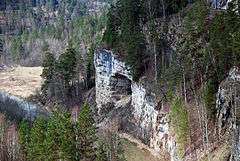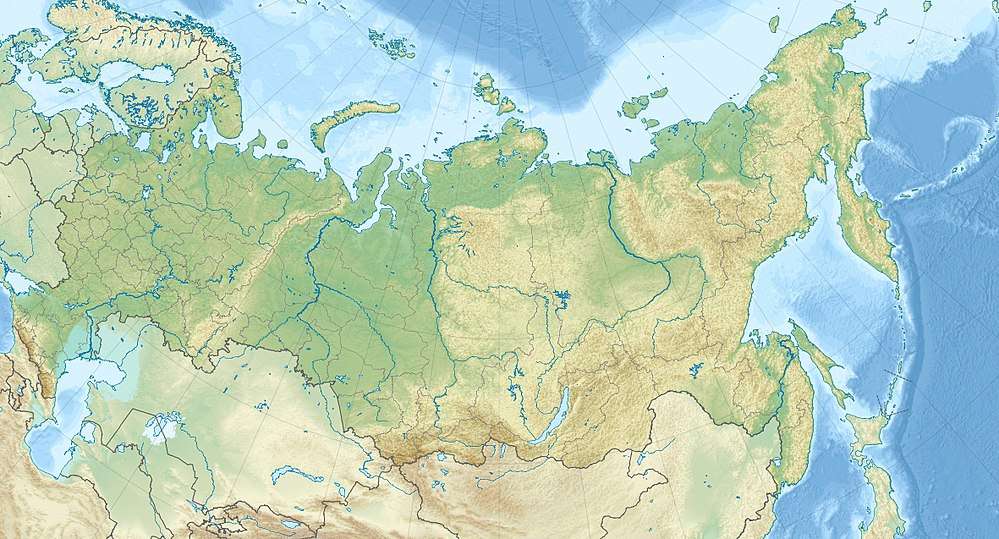Ignatievka Cave
Ignatievka Cave (Ignateva cave, Ignatievskaya cave, Russian: Игнатьевская пещера, also known as Yamazy-Tash) is a large limestone cave on the banks of the Sim River, a tributary of the Belaya river in the southern Ural Mountains of Russia.[1][2] In 1980 a parietal wall painting of a venus figure was discovered. The twenty-eight red dots between her legs are believed to represent the female menstrual cycle.[3][4]
Игнатьевская пещера | |
 Sim river and cave entry | |
 Location in Russia | |
| Alternative name | Yamazy-Tash |
|---|---|
| Location | on the banks of the Sim River, Sim, Chelyabinsk Oblast |
| Region | southern Ural mountains |
| Coordinates | 54°53′57″N 57°46′50″E |
| Type | limestone cave |
| History | |
| Periods | Paleolithic |
The cave also contains microliths, remains of animals and more cave paintings, as well as a stratum of Iron Age settlement.[5] Although some sources associate the paintings to the Upper Paleolithic,[5] radiocarbon dating of the pigments has resulted in more recent numbers, between 6,000 and 8,000 years ago.[6]
Ignateva Cave can be freely visited although it is best to travel via the small village of Serpiyevka, which is off the main road past Sim, Chelyabinsk Oblast, heading eastwards, about 15 km (9.3 mi). The track to the cave is very rough and has not been improved for years. The cave mouth is about 18 m (59 ft) above the small river backwater and reached by a metal ladder. On entering the cave visitors must stoop low as the ceiling lowers quickly to about 1 m (3.3 ft) in height, and then it increases again to 2 m (6.6 ft) or more. Part of the inner cave can only be reached by crawling through a very narrow space about 0.5 m (1.6 ft) in height but this provides views of some of the better red ochre markings. The local guide from Serpiyevka noted that the cave was not lived in (there were no fire markings), but hypothesized that it was a sacred site mainly used for religious ceremonies and adulthood rites from the markings.
The Kapova cave is located some 120 km (75 mi) from the Ignatievka cave.
.jpg) Alternative view of cave entrance
Alternative view of cave entrance Looking out from the cave
Looking out from the cave Ochre figure of a person
Ochre figure of a person
References
- Bahn, Paul G. (1993), Collins Dictionary of Archaeology, ABC-CLIO, p. 224, ISBN 0-87436-744-1.
- Shirokov, Vladimir (2002), Review of the Ural cave and rock art, The Northern Archaeological Congress, archived from the original on 2007-08-10
- Rudgley, Richard (1998), Lost Civilisations of the Stone Age, Century, p. 196, ISBN 0-7126-7758-5.
- Blackledge, Catherine (2004), The Story of V: A Natural History of Female Sexuality, Rutgers University Press, p. 37, ISBN 0-8135-3455-0.
- Kipfer, Barbara Ann (2000), Encyclopedic Dictionary of Archaeology, Springer-Verlag, p. 250, ISBN 0-306-46158-7.
- Steelman, K. L.; Rowe, M. W.; Shirokov, V. N.; Southon, J. R. (2002), "Radiocarbon dates for pictographs in Ignatievskaya Cave, Russia: Holocene age for supposed Pleistocene fauna", Antiquity, 76 (292): 341–348.
| Wikimedia Commons has media related to Ignateva Cave. |